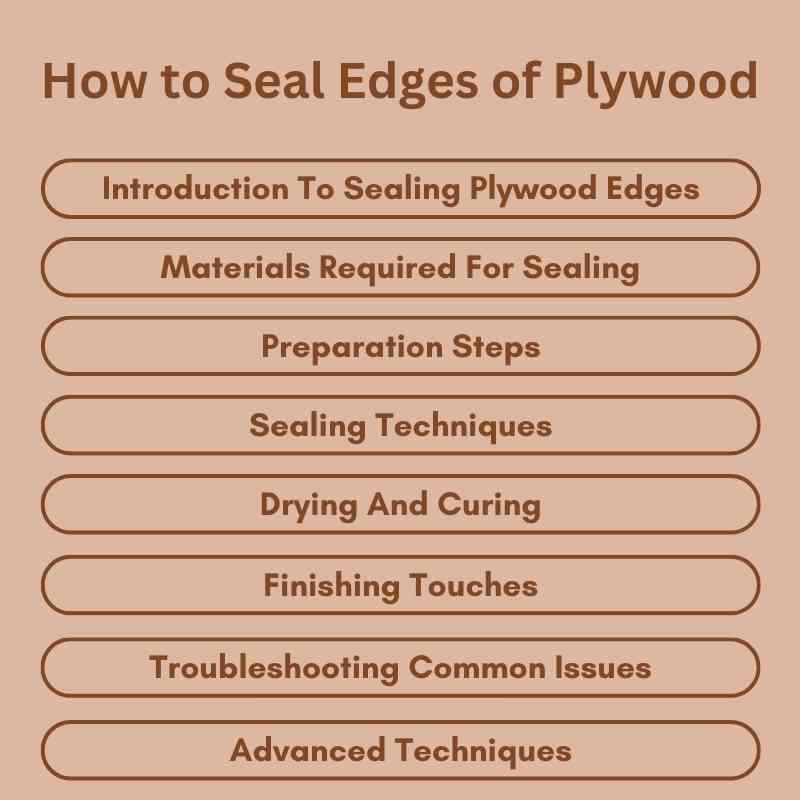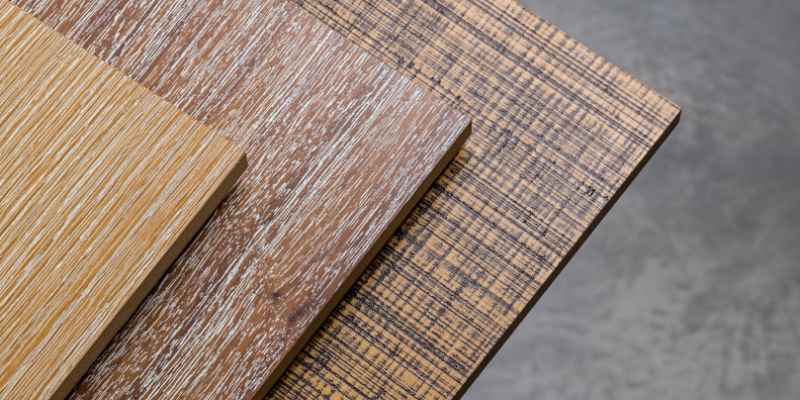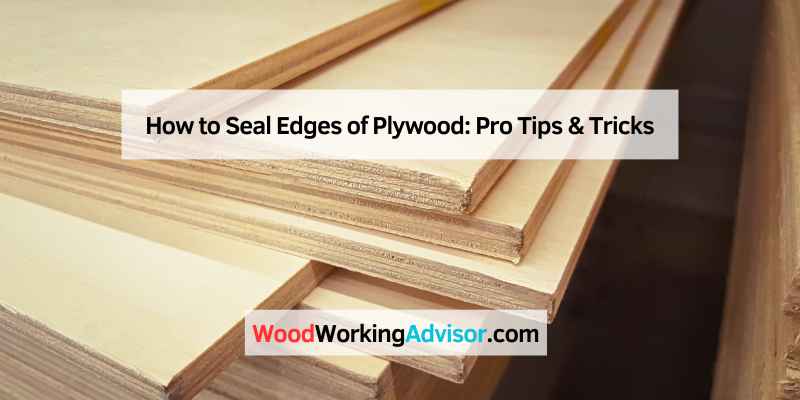To seal the edges of plywood, use a high-quality wood sealant or paint. Apply the sealant with a brush or roller, ensuring even coverage.
Plywood is a versatile material used in various projects, from furniture to cabinetry. However, its edges are particularly susceptible to moisture damage, which can lead to swelling and deterioration. Sealing the edges effectively protects plywood from water and enhances its durability.
Selecting the right sealant is crucial for optimal results. Options like polyurethane, varnish, or specialized wood sealers can provide excellent protection. Proper application not only preserves the plywood’s integrity but also improves its appearance. Understanding how to seal plywood edges effectively ensures that your projects last longer and maintain their aesthetic appeal.
Introduction To Sealing Plywood Edges
Sealing plywood edges is very important for durability. Unsealed edges can absorb moisture easily. This leads to swelling and damage over time. Proper sealing helps to protect the plywood.
Benefits of sealing include:
- Prevents Water Damage: Sealed edges stop moisture from entering.
- Increases Lifespan: Proper sealing extends the life of the plywood.
- Improves Appearance: Sealing gives a smooth and finished look.
- Reduces Splitting: Sealing helps avoid cracks and splits in the wood.

Materials Required For Sealing
To seal the edges of plywood, you need a few materials. Sealants are very important for this task. Choose a sealant that is water-resistant and suitable for wood. Options include polyurethane, epoxy, or latex-based sealants.
For application, gather the right tools. You will need a paintbrush or a roller for even spreading. A putty knife can help fill gaps. Don’t forget to have sandpaper for surface preparation. Always wear gloves and a mask for safety.
Preparation Steps
Start by cleaning the edges of the plywood. Use a dry cloth to wipe off any dust. A clean surface helps the sealant stick better.
Next, focus on sanding for smoothness. Use fine-grit sandpaper to smooth the edges. This step prevents any rough spots from showing after sealing.
Make sure to sand in the direction of the grain. This technique ensures a better finish and helps the sealant adhere properly.
Sealing Techniques
The Brush Application Method is simple and effective. Use a high-quality brush for even coverage. Apply the sealer in smooth, long strokes. This method allows for better control and precision.
The Roller method works well for larger surfaces. Choose a roller with a medium nap. Roll the sealer on in a uniform manner. This technique covers more area quickly.
Spray Sealing is fast and efficient. It reaches tight corners easily. The downside is that it can create overspray. Proper ventilation is important during this process.
| Method | Pros | Cons |
|---|---|---|
| Brush Application | High control, good for details | Time-consuming for large areas |
| Roller | Covers large areas quickly | Less control in corners |
| Spray Sealing | Fast, reaches tight spots | Overspray, needs ventilation |
Drying And Curing
Proper drying conditions are crucial for sealing plywood edges effectively. Aim for a temperature between 70°F and 80°F. Keep humidity levels low, ideally below 50%. Good air circulation helps the drying process.
The curing time for sealants varies. Most products need 24 to 48 hours to cure fully. Some sealants may take longer, so check the label. Always wait until the surface feels dry to the touch before using the plywood.
Finishing Touches
Proper sanding after sealing is essential for a smooth finish. Use fine-grit sandpaper to gently smooth the edges. This helps remove any rough spots and uneven areas.
After sanding, wipe the surface clean. This removes dust and ensures better adhesion for the next coat. Apply additional coats of sealant for maximum protection. Each coat should dry completely before applying the next one.
| Step | Description |
|---|---|
| Sanding | Use fine-grit sandpaper for a smooth finish. |
| Cleaning | Wipe away dust after sanding. |
| Coating | Apply multiple coats for better protection. |
Troubleshooting Common Issues
To prevent bubbles and blotches on plywood edges, choose the right sealant. Apply a thin layer. Use a brush or roller to spread evenly. Wait for the first coat to dry before applying a second coat. This method reduces imperfections.
For drips and runs, work in small sections. Always keep the sealant can upright. If drips occur, use a clean cloth to wipe them away immediately. For best results, maintain a steady hand while applying the sealant.
Remember to always read the manufacturer’s instructions. Following these steps can lead to a smooth and professional finish.
Maintenance Tips
Regular checkups help maintain the integrity of plywood edges. Look for signs of wear or damage. Small issues can lead to bigger problems. Inspect the sealant for cracks or peeling. Replace any damaged areas quickly to prevent moisture damage.
Repairing damaged sealant is crucial for long-lasting plywood. Remove the old sealant carefully. Clean the area to ensure proper adhesion. Apply a new, high-quality sealant. Smooth it out for a neat finish. Allow it to cure fully before using the plywood.
Advanced Techniques
Edge banding improves the look of plywood edges. It covers rough edges and gives a smooth finish. Choose from different materials like wood veneer or melamine. These choices help match the plywood to your decor.
To apply edge banding, use a hot glue iron. This method ensures a strong bond. Cut the banding to the right size, then press it on the edge. Trim any excess material for a clean look.
Waterproof seals protect plywood from moisture. Use a waterproof sealant for the best results. Apply the sealant evenly on all edges. Let it dry completely for full protection.
Regular maintenance helps keep the seals effective. Check for any wear or damage regularly. Reapply sealant as needed to maintain waterproofing.
Safety Considerations
Proper ventilation is essential when sealing edges of plywood. Open windows and doors to let fresh air in. Use fans to help circulate the air. This reduces fumes and keeps the workspace safe.
Wearing the right personal protective equipment is crucial. Always wear safety goggles to protect your eyes. A mask helps prevent inhaling harmful chemicals. Gloves keep your hands safe from irritants. Make sure to wear ear protection if using loud tools.
Environmental Considerations
Choosing eco-friendly sealing options is great for the environment. Look for water-based sealants that have low VOCs. These products are less harmful to air quality. Natural oils like linseed oil are also excellent choices. They provide protection without toxic chemicals.
For disposal of waste materials, always follow local regulations. Many sealants come in containers that can be recycled. Never pour leftover sealant down the drain. Instead, let it dry out completely. Dispose of it with regular trash. Always prioritize safe disposal methods to protect the environment.
Case Studies
Sealing the edges of plywood enhances durability and prevents moisture damage. Various techniques, such as paint, varnish, or specialized sealants, can effectively protect your projects. Explore these practical methods to achieve a smooth, long-lasting finish on your plywood surfaces.
Professional Projects
Many professionals use edge sealing for durability. This helps protect plywood from moisture. A well-sealed edge can extend the life of the material. Projects like furniture and cabinets benefit greatly from this process. Using a quality sealant ensures a long-lasting finish.
Diy Success Stories
Many DIY enthusiasts share their sealing experiences. Simple techniques yield great results. Applying sealant with a brush works well. Spray-on sealants are also popular for quick jobs. People enjoy saving money while achieving professional-looking results. Learning from these stories inspires others to try sealing edges.

Frequently Asked Questions
How Do I Seal Plywood Edges Effectively?
To seal plywood edges effectively, use a quality wood sealant or primer. Apply it with a brush or roller for even coverage. Allow it to dry thoroughly before applying a topcoat for added protection. This will prevent moisture absorption and enhance durability.
What Materials Do I Need For Sealing Plywood Edges?
You will need wood sealant, a paintbrush, sandpaper, and a clean cloth. Optionally, a primer and a topcoat can provide additional protection. Choose products specifically designed for plywood to ensure compatibility. Having the right tools simplifies the sealing process and improves results.
Can I Use Paint To Seal Plywood Edges?
Yes, paint can seal plywood edges, but it’s not ideal. While it provides a barrier, it may not penetrate as deeply as sealants. For better moisture resistance, consider using a specialized wood sealant or primer. This ensures long-lasting protection against wear and tear.
How Many Coats Of Sealant Should I Apply?
Typically, two to three coats of sealant are recommended. Apply the first coat, allow it to dry, then lightly sand. This promotes adhesion for subsequent coats. More coats enhance protection and durability, especially in high-moisture areas.
Conclusion
Sealing the edges of plywood is essential for durability and moisture resistance. By using the right techniques and materials, you can enhance the longevity of your projects. Whether for furniture or construction, proper sealing ensures a professional finish. Invest time in this step to protect your investment and enjoy lasting results.

